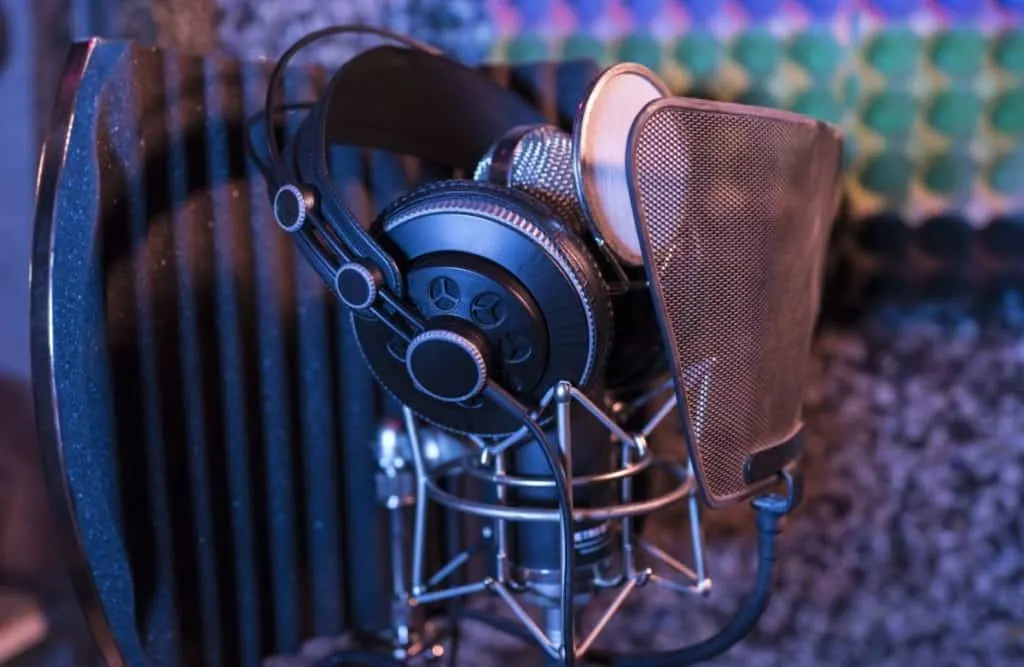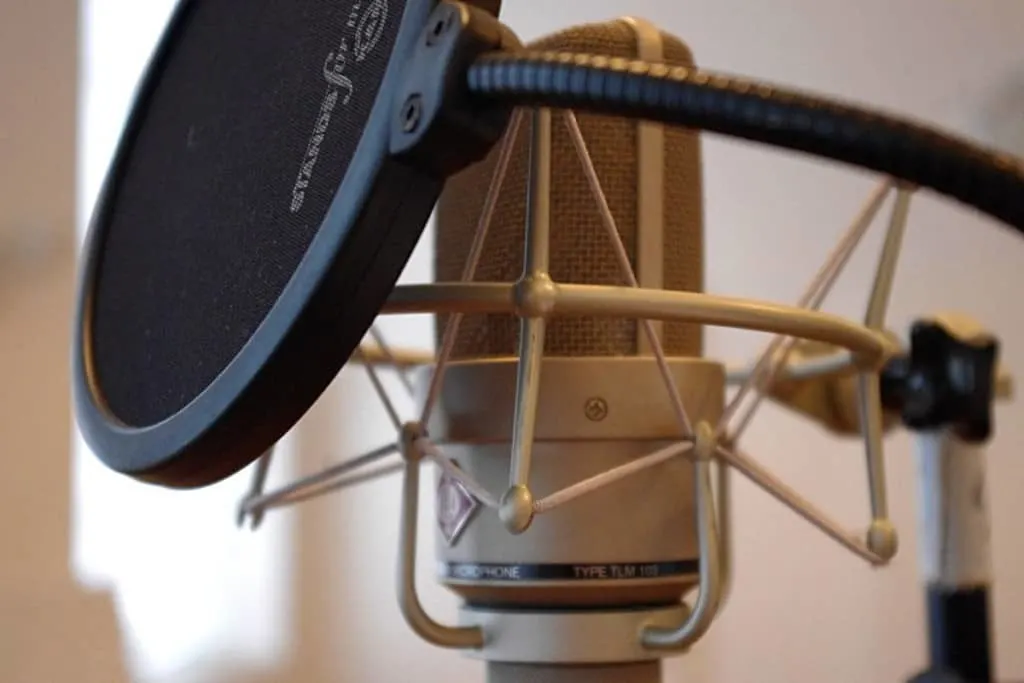Pop filters improve the clarity of vocal recordings. They do this by preventing plosives from directly coming into contact with a microphone’s inner components, which causes a “pop” sound to be present in the recording.
Are metal pop filters better?
In terms of durability and longevity, metal pop filters are better. They are effective at redirecting the air which is created by a vocalist’s plosives away from the microphone. Compared to other materials, they produce a different sound which many consider to be better.
As is the case with all recording equipment, the answer to this question is subjective.
There’s no doubt that metal pop filters are exceptional tools for minimizing plosives in a vocal recording, but to compare them to other alternatives requires some further investigation.
In this comprehensive guide, I’ll discuss the various benefits and potential downsides to metal pop filters.

The Pros Of Metal Pop Filters
Rather than resisting the air from a vocalist’s mouth, or diffusing it, metal pop filters deflect it away from the microphone’s diaphragm.
They are very capable and useful pieces of equipment if you want to capture vocal recordings with the best possible quality.
To understand the benefits of metal pop filters, we need to consider why they are needed.
Vocal recordings are usually done using a condenser microphone. These mics are known for their attention to detail, and although dynamic mics are preferred by some, it’s more common that a condenser will be used for capturing the human voice, especially in a studio recording situation.
The microphone has an inner diaphragm which is largely responsible for receiving the sounds. The human voice consists of numerous variations of air pressure which are pushed out of the mouth.
When the air is pushed out of a person’s mouth, there are many different sounds created. Plosives are a category of these sounds, which are made up of consonants. When a person sings or talks, they produce plosives whenever the letters t, k, p, d, g, or b are used.
From a technical standpoint, plosives are produced when the vocal tract is blocked, and airflow is halted. This is usually caused by the top of a person’s tongue touching their lips or their lips coming together for a brief moment.
The main area in which metal pop filters are better than other materials, Is redirecting the plosives away from the microphone.
The singer’s vocals are directed towards the mic’s diaphragm, but a metal pop filter is placed between them and the microphone. As the plosives leave their mouth, they come into contact with the metal and this causes them to be deflected away before they enter the diaphragm and make their way onto a recording.
Check out this video that shows how to get a pop filter set up.
Nylon Pop Filters
In addition to metal pop filters, the nylon variety is the most popular. Although both materials essentially aim to achieve the same end goal, their method of doing so is contrasting.
- Nylon mesh pop filters, rather than deflecting the air away from the microphone, diffuse it.
This slows down the air that is produced by the vocalist before it reaches the diaphragm. To do this, two layers of nylon are used, forming a barrier between the vocalist and the microphone.
Metal pop filters only use a singular layer, because they aren’t designed to diffuse or slow down the air, but rather to redirect it before it comes into contact with the microphone.
It could, therefore, be argued that they are better than their nylon equivalents because they use a more hands-on approach to minimizing plosives.
The table below summarizes the different qualities of metal and nylon pop filters:
| Metal Pop Filters | Nylon Pop Filters |
| Redirect the air | Diffuse the air |
| Deflect plosives away from the microphone | Slow down plosives before they enter the microphone |
| Single-layered | Double-layered |
Concerning sound, it’s hard to definitively say which material of pop shield is “better”.
This is a matter of opinion, with some vocalists preferring the softening process of nylon pop filters, and others siding with the more hands-on deflection approach of metal pop filters.
There are, however, noticeable differences that are likely to offer benefits to certain vocal styles.
Firstly, metal pop filters reduce plosives more aggressively. They are very effective at preventing the air from entering the microphone. This is largely a result of the dense and durable nature of metal, which halts the air and sends it in another direction.
The only downside to this aggressive approach is that in some cases, it can cause other vocal sounds to be deflected too.
Although plosives are generally seen as undesirable in a vocal recording, it’s important in many cases to retain the human feel without completely removing the sounds caused by changes in air pressure.
Nylon mesh pop filters are less aggressive in their approach. They aim to slow down the air rather than deflect it, and therefore inevitably more air gets through the shield into the microphone capsule.
Some would argue that this results in a more natural, authentic vocal recording. The trade-off, however, is that compared to metal pop filters, nylon versions are more likely to let the odd “pop” get through.
The only reliable way to decide whether metal pop filters are genuinely better than other materials is to experiment with them yourself. That way, you can gauge their ability to prevent pops, but also observe the overall effect they have on the sound of your vocal recording.
Can You Use 2 Pop Filters?
This is a question I am often asked. I have written an article on this subject. You can read it here.
Pop Filter Attachments & Stability
In addition to their ability to minimize plosives and improve recording clarity, metal pop shields also offer other qualities that can make them better than other options. One of these factors is how securely they can connect to the microphone stand.
When using a metal pop shield, or any other type for that matter, the connection between it and the mic stand must be secure. Many metal pop filters are fitted with clamps, which come in different varieties.
In general, higher-quality metal pop filters will have better clamps for attachment purposes.
Some use a screw-clamp, which tightens around the pole of a microphone stand and holds the shield firmly in place. Others use a spring-clamp, which releases tension when squeezed and clamps onto the stand when released.
A metal pop filter’s effectiveness is directly correlated to the security of its clamp.
If the connection is loose and flimsy, this increases the risk of the shield moving while you are recording. This can cause the filter to come into contact with the microphone, which will cause unwanted noise to be present in the recording.
Another component that makes the security of metal pop filters better is the gooseneck. This connects the filter to the clamp and needs to be flexible enough to be correctly positioned in front of the microphone.
This flexibility needs to be combined with robustness so that the gooseneck is strong enough to support the weight of the metal shield and prevent it from moving or dropping down during a vocal recording.
Again, cheaper metal pop shields are usually inferior in this respect, while more expensive ones tend to offer a better blend of flexibility and stability.
Pop Filter Visibility & Maintenance. Metal vs Nylon
Another area, in which metal pop shields are better than nylon alternatives, is visibility.
Commonly, a vocalist will need to see a lyric sheet or musical notation when recording. The music stand is usually placed directly in front of the singer so that they can retain the correct posture while reading from it.
If the music stand was positioned to the side of the pop filter, the singer’s voice would be directed away from the microphone, resulting in a compromised recording. Nylon pop filters are dense in appearance, whereas metal ones tend to be more transparent.
This allows the singer to look through the metal pop shield while recording and being able to see the lyrics or notation positioned in front of them. They don’t obstruct the view as much and therefore are much better in this respect.
Pop filters are prone to getting damp and dirty after being used, because of the moisture in the singer’s breath that they are constantly subjected to. Therefore, it’s important to clean them regularly to keep them fresh and usable.
Nylon pop filters are difficult to clean because the moisture is captured by the mesh.
Metal pop filters are much easier to clean. The hard material can simply be wiped with a cloth. For this reason, amongst the others listed in this article, it’s safe to say that metal pop filters are better.

Related Questions On Metal Pop Filters
What is a vocal isolation shield?
Vocal isolation shields are made up of panels that cover the immediate area surrounding a microphone. They are used to deaden the sound and isolate the vocals for the cleanest recording possible.
Check out these vocal isolation shields on Amazon.
Does acoustic treatment matter?
Although the difference is subjective, acoustically treating a room for recordings will allow you to be more precise. Using acoustic panels is a great way to prevent problem frequencies from marring your recordings.
What is an omnidirectional mic?
Omnidirectional microphones pick up all of the sounds that surround them equally. This means that no matter where you stand the microphone will capture your voice.
